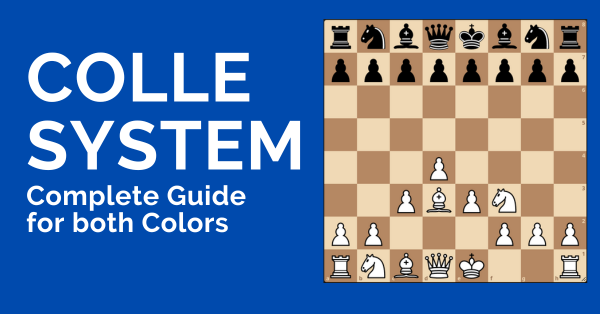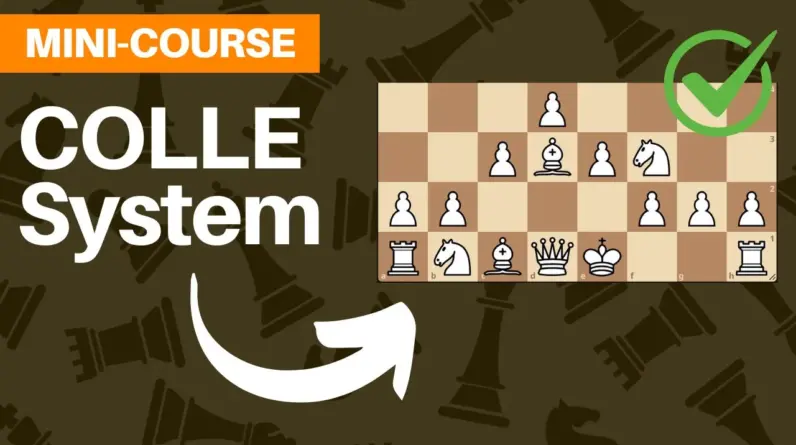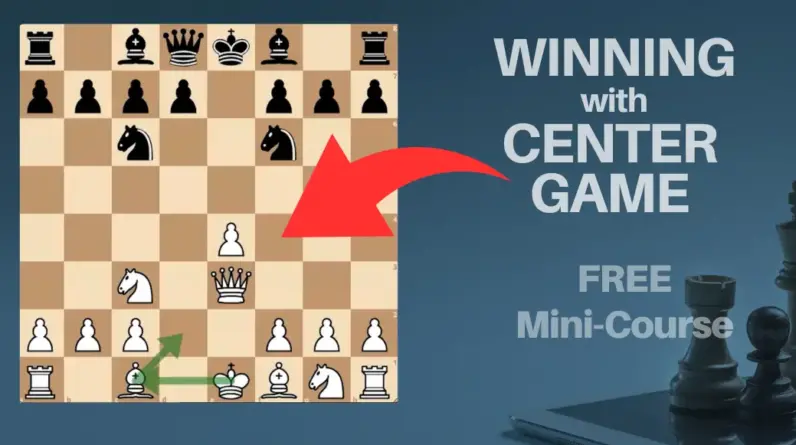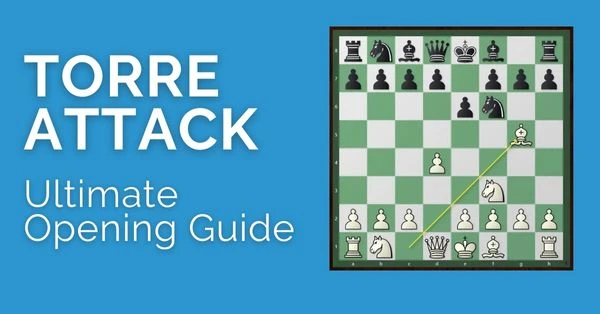
In the Torre Attack, White prioritizes development and aims to control the center with the pieces.
The opening moves of the Torre Attack are as follows.
How to get to Torre Attack?
These are the moves that get you to the starting position of the Torre Attack:
1.d4 Nf6 2.Nf3 e6 3.Bg5
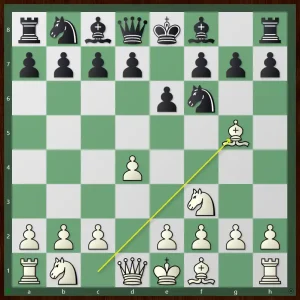
In the Torre Attack Instead of the common space gaining move 2.c4, white opts to develop a piece with Nf3.
At the amateur level, White often reaches an easy-to-play position. The pieces are harmoniously set up so that White can hope for decent attacking chances. The main reason White players go for the Torre is to avoid known paths of play.
White establishes a strong base in the center with d4, this further acts as an anchor for minor pieces to conduct attacks. White strengthens the single central d-pawn further with the c and e-pawns with the moves c3 and e3.
You should not confuse such an opening strategy as weak or unambitious because, in the Torre Attack, careless or routine play by the Black side can be swiftly punished by White.
White’s Torre Structure with c3 and d4
White erects the triangular c3-d4-e3 pawn structure in the center.
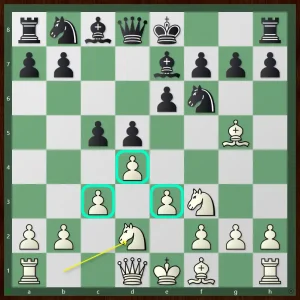
This structure is common in system-based openings and is seen in London and Colle Systems as well.
This structure grants White a solid base of operations upon which he can look to build an attack.
Naturally, by making the move c3, it means that you put another pawn on the dark square. This means that the c1 bishop is ‘bad’ and the f1 bishop is good.
However, the c1 bishop doesn’t face any difficulty because it can come out of the pawn chain and develop freely.
The only problem is that it is not able to switch to the Queenside quickly. White overcomes this by keeping the Bishop on the Kingside and choosing a plan to play around the Bishop.
By moving the c-pawn, the d1-a4 diagonal is made available to the Queen. We see this in many variations where White meets Qb6 with Qb3.
The move c3 also takes away the natural development square from the Knight. So the knight is often deployed to d2.
Therefore the natural scheme of development for the pieces is shown below:
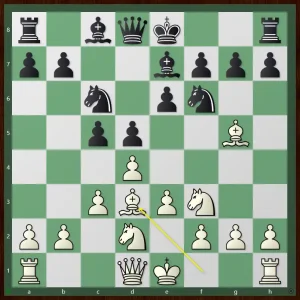
Torre Attack: Black Plays 2…e6
We shall now look at 1.d4 Nf6 2.Nf3 e6 3.Bg5

The move 2..e6 has three consequences:
- Prepares to develop the f8 bishop
- It allows White to establish a pin along the h4-d8 diagonal
- The Queen supports the knight so if an exchange happens the Queen can recapture hence avoiding the doubled pawns.
In this structure, Black can include or omit 3..d5. It’s up to the preference of the player. Now white can play 4. Nbd2,4. c3, or 4.e3.
After this, the first question that arises is: Is it a good idea for Black to kick the Bishop with h6?
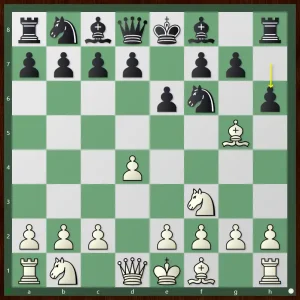
After h6 White has three options:
Retreat the Bishop to h4: Now the Bishop is unable to return to the Queenside. Black can make use of this with a quick queenside counter (c5-Qb6). But this can lead to doubled pawns on the Kingside after Bxf6. Therefore, it leads to a complex game but computers give the position as equal.
Black also has the option to harass the Bishop further with g5. Even though these pawn moves look aggressive (h6-g5) they give Black permanent weaknesses that White can hope to exploit.
The other option is to play the Bishop to f4. In this line, White manages to keep the Bishop on the c1-h6 diagonal so that it can return to the Queenside. The downside is that the pin is broken and the Bishop is prone to an attack by the Knight (Nd5)
The final option is to exchange on f6. In this line, Black gets the Bishop pair in exchange for space and time. White gets space because he is quickly able to arrange e4 and get the e4-d4 pawn duo in the center.
After the exchanges Black should aim to develop quickly otherwise he risks being overrun by White’s pieces.
The following game demonstrates the Key ideas in this line.
A key moment in the Game:
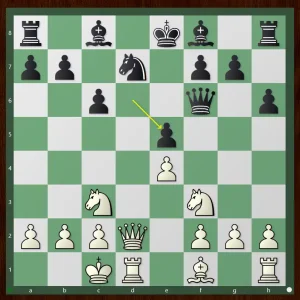
How can White exploit Black’s lack of development?
Klinger vs King, 1989
Now we come to lines where Black plays without h6. From this position, Black has a plethora of options to choose from.
The most common continuations at the Club level are 3..Be7 and 3..d5. Often they transpose into one another.
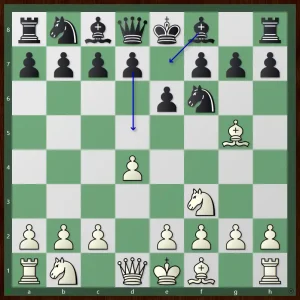
By arranging the pawns in the spirit of Queen’s Gambit Declined, Black gains control of the e4 square. It is the only square that is not controlled by any of White’s pieces. However, the consequence of playing d5 is that it weakens the e5 square, which White often uses as a base for his Knights.
After 5.Nbd2 The direction of the game depends on how Black chooses to develop the pieces. Since Black commits to e6, you can fianchetto the Bishop to b7 or sometimes to a6 to exchange it off for its active counterpart on d3.
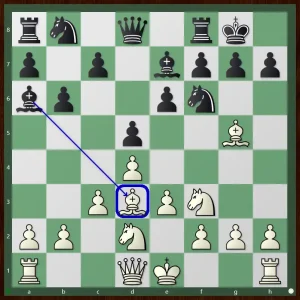
The following game demonstrated the attacking potential of the Torre Attack. The lesson from the game is that Black should be very careful while castling, if he times it wrong then he risks castling into a devastating attack.
In the game, the attack was so strong that even an excellent defender like Anand couldn’t stop it.
Mohr vs Anand, Belgrade 1988
Black can also play without d5. The idea is to keep the center flexible and strike at the correct moment. The principled continuation for Black here is to play c5 and Qb6, putting immediate pressure on the Queenside and Center.
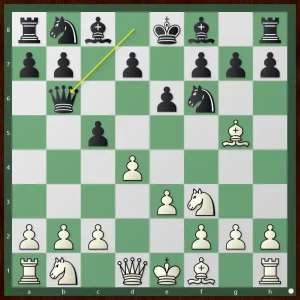
This is the sharpest and most forcing line in the Torre Attack, so a concrete knowledge of variations is needed. To learn the latest developments in this line you can learn this course.
Torre Attack – Black Plays 3…Ne4
1.d4 Nf6 2.Nf3 d5 3.Bg5 Ne4
The forward Knight thrust is a crucial continuation as it questions the early Bishop move and prepares for a quick central counterplay.
It avoids the weakening of the Black pawn structure with Bxf6. Black hopes to seize the initiative by gaining a tempo on the Bishop.
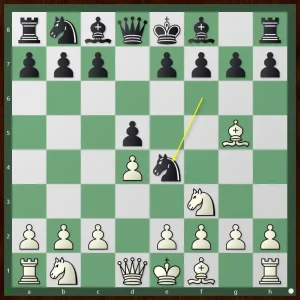
You can play this maneuver after 2..g6 3.Bg5 and 2..b6 3.Bg5.
The two most popular continuations are 4.Bf4 and 4.Bh4
4.Bh4 leaves the Bishop on a less active square, White hopes that it will interfere with Black’s development but a major downside as we have seen before is that it loses touch with the Queenside. This allows Black to prepare pressure against the b2 pawn by advancing 4..c5 and Qb6. Black can also play routinely with Nc6 as well.
After 4.Bf4 the principles continuation is 4..c5. Now White has to support the center with either c3 or e3. Both have their pros and cons. E3 simultaneously opens the diagonal for the f1 bishop whereas c3 aims to counter 5..Qb6 with 6.Qb3
White will exchange the Knight with Nbd2 and develop his pieces according to the scheme of development adopted by Black.
[embedded content]
White’s Powerful Trap in the Torre Attack
The Torre Attack contains many traps that can be set by the White player. Here is one trap where Black plays a logical move but is a tactical blunder
1.d4 d5 2.Nf3 Nf6 3.Bg5 e6 4.e3 Be7 5.Bd3 O-O 6.O-O c5 7.c3 Nbd7
Both sides have developed their piece harmoniously. White now places the knight on the central e5 square. A common theme in the Torre Attack.
8.Ne5 b6
9.f4
White bolsters the center with f4 and makes preparations for a Kingside assault.
9..Ne4??
Black jumps into the e4 outpost but this is a huge blunder.
10.Nc6
Conclusion
In the Torre Attack, knowledge of the key motifs for each side is much more important than memorizing specific theoretical sequences.
This opening is a powerful tool at the amateur level as White can grab the initiative if Black makes a slight error.
The plans are easy to understand and implement. Some variations require work but if done so the Torre Attack is an amazing weapon to have in one’s repertoire.
FAQ
Is The Torre Attack a good opening?
Yes, the Torre Attack can be a good surprise weapon for white, offering active play and flexibility.
Who invented the Torre Attack?
The young Mexican Master Carlos Torre first played it in a high-profile tournament in November 1925. He used the opening to great effect and beat players like Saemisch and Lasker.
What is the difference between Trompowsky and Torre?
Both develop the dark-squared bishop actively, but the Trompowsky delays Nf3 while in the Torre you play Nf3 first followed by Bg5.
How to beat Torre Attack?
There isn’t a refutation for the Torre Attack but Black can get a decent game in many lines. Some of these lines are where Black plays an early c5 with Qb6 or an early d5.
Which Grandmasters Play Torre?
Some of the prominent Grandmasters who have played the Torre Attack are Tigran Petrosian, Pentala Harikrishna, Alexey Dreev, and Krishnan Sasikiran have used the Torre Attack effectively.
Is Torre Attack a good opening for beginners?
Yes, it is a good opening for Beginners as it has an easy development scheme and plans. It is a flexible opening as well. This makes it a good choice for Beginners.
How to learn the Torre Attack?
We have a collection of excellent resources here at TCW to learn chess openings. If you want to learn Torre Attack, make sure to check out the recent Lemos Formula course on Torre Attack by GM Damian Lemos. He developed this top-scoring opening preparation focusing on boosting your wins with White and slashing your study time.

